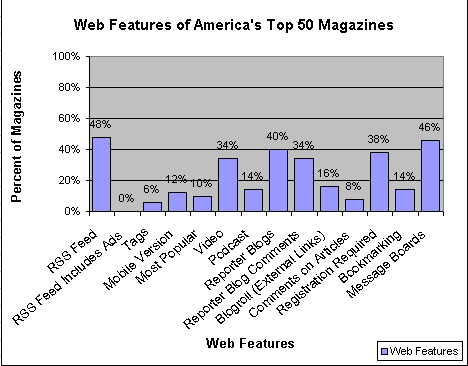TBG has recently completed a research study called "Analyzing the Presence of Magazines on the Internet". In the wake of success surrounding our previous newspaper study, "The Use of the Internet by America's Newspapers ", we decided to conduct similar research on the magazine industry. Our study reviews the websites of the top 50 most circulated magazines in the United States and evaluates them based on the presence or absence of various Web 2.0 features. After finishing the research, it became clear that magazines are not making use of Web 2.0. Despite their failure in terms of Web features, it should be recognized that magazines have taken on a more effective general strategy than newspapers when it comes to the Internet. Instead of replicating printed content online, as newspapers do, magazines have made efforts to publish unique, Web specific, and easily digestible materials on their websites. In this way, magazines are using the Internet as a supplement to, rather than a replacement of, their printed publications. Magazine websites limit their article content and focus on pushing customers to purchasing printed subscriptions. Here are some key findings from our research:
- The most common online feature offered by magazines is RSS feeds (48 per cent). All of the RSS feeds offered by magazine websites are partial feeds. In addition, none of the magazines are including advertisements in their RSS feeds, while just 28 per cent of magazines divide their RSS feeds into different sections.
- Message boards/forums are offered by 46 per cent of magazine websites. This seemingly old-fashioned form of communication is extremely popular on magazine websites, particularly on the sites of women’s magazines.
- 38 per cent of the magazines require registration to view all of the site’s content. While this feature is only present on 23 per cent of the nation’s top 100 newspaper sites, it seems that magazines are still heavily reliant on website registration. It must be noted, however, that newspaper and magazine online registration is very different. The large majority of the magazines we investigated allow users to view article content free of registration. However, to participate in forums, registration is required. This seems to serve as a mechanism for monitoring content that people post on message boards rather than to collect demographic information, as is the case with newspapers. Thus, this 38 per cent figure largely represents magazines that require forum registration, not registration for the purpose of reading articles.
- 40 per cent of the magazines offer at least one reporter blog. Readers can comment on 17 of the 19 magazine blogs, while eight reporter blogs offer blogrolls, or external links to other blogs.
- Video is an offering on 34 per cent of websites.
- Just 14 per cent of websites use podcasts and bookmarking; eight percent allow comments on articles; and six per cent use tags.
You can read the report in its entirety here and view our data sheets here Please take a look and let us know what you think!
